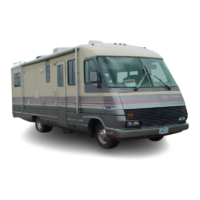69
Discovery, Discovery LXE, Pace Arrow, and
portion of the wall covering to
ensure the cleaner does not affect
the color or gloss of the wall
covering.
Specic Stain Type Removal
Procedures:
Normal Dirt:
Remove normal dirt using a
mild soap or detergent and warm
water. Allow it to soak for a few
minutes then rub briskly with a
cloth or sponge.
Nail Polish, Shellac or
Lacquer:
Remove liquid using a dry cloth.
Use care not to spread the stain.
Quickly clean the remaining
stain with rubbing alcohol. Rinse
with clean water.
Ink:
Remove immediately by
wiping with a cloth dampened
in rubbing alcohol. Rinse with
clean water.
Chewing Gum:
Rub with an ice cube to cool and
harden. Gently pull off the bulk
of the gum. Remove remaining
gum with rubbing alcohol.
Pencil:
Erase as much of pencil mark as
possible. Wipe remaining marks
with rubbing alcohol.
Blood, Feces or Urine:
Remove these staining
substances as quickly as
possible. Wash the stained area
with a strong soap. If the stain
does not disappear, rinse the
soapy area thoroughly with
clean water. Mix a solution of
50% water and 50% household
bleach. Clean the stained area
with the bleach solution. Rinse
with clean water.
WOOD CARE
For general cleaning, regularly
wipe wood surfaces using a soft
cloth lightly dampened with
clear warm water. Thoroughly
dry to prevent streaking. For
stubborn stains, use a clean cloth
dampened with a solution of mild
non-alkaline soap (dish washing
liquid) and water and rinse. Dry
thoroughly, bufng in the direction
of the wood grain. Never use
abrasive cleaners, scouring pads
or powdered cleansers. Polishing
products used on the solid wood
surface depends on individual
preference. Always follow product
instructions.
Excessive dampness, dryness,
heat, or cold can damage solid
wood nishes. Sunlight can change
the color or age the wood. Never
allow moisture or spills to stand,
always blot dry immediately.
Solvents, alcohol, nail polish and
polish removers, as well as harsh
cleaners, should not be used on
nished wood surfaces.
Minor damage to solid wood
surfaces can be repaired quickly
and effectively with a bit of hard
work, some careful attention to
details, and most importantly, the
right materials. However, any
wood repair or nishing job is best
left for a professionally trained
individual.
NOTE:
It is important to inform
the service technician of
any products used for the
care and cleaning in the
event of wood repairs.
Sanding and Sandpaper:
The following table is a general
guide and may vary with wood
type. The key to sanding is using
the right sandpaper for the repair
that is needed. Always sand with
the grain.
GRIT GRADE USE
80-120 Medium
Smoothing the surface,
removing small marks.
150-180 Fine
Final sanding prior to
nishing.
220-240 Very Fine
Sanding between
coats of sealing.
280-320 Extra Fine
Removing dust spots
or marks between
nish coats.
360-600 Super Fine
Removing luster or
surface blemishes.

